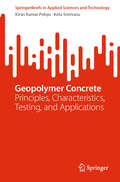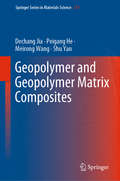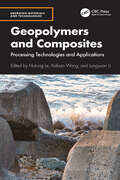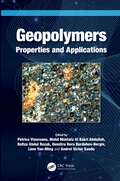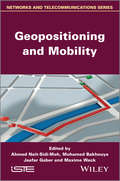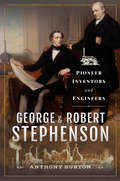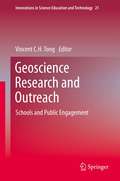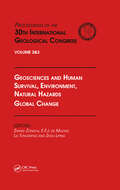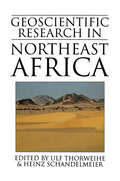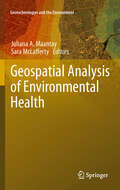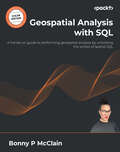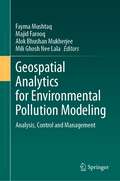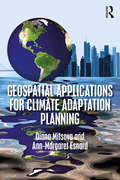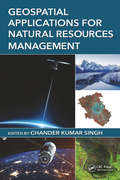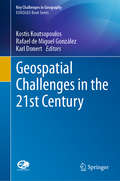- Table View
- List View
Geopolymer Concrete: Principles, Characteristics, Testing, and Applications (SpringerBriefs in Applied Sciences and Technology)
by Kiran Kumar Poloju Kota SrinivasuThis book discusses geopolymer concrete, an innovative and sustainable alternative to traditional Portland cement concrete. Geopolymer concrete is synthesized through the chemical reaction between industrial byproducts, such as fly ash or blast furnace slag, and alkaline activators. It offers environmental sustainability by utilizing industrial waste materials as its main components, reducing carbon footprint and resource depletion. The production process of geopolymer concrete further contributes to its eco-friendly profile as it can be cured at ambient temperatures or with minimal heat input, significantly lowering energy consumption and greenhouse gas emissions. The chemistry of geopolymer involves the dissolution of aluminosilicate materials in a highly alkaline environment, followed by the condensation and reorganization of silica and alumina species to form a three-dimensional network structure. The research on geopolymer concrete is important for several reasons. First, it provides a sustainable alternative to traditional Portland cement concrete, which has significant environmental impacts due to its high carbon dioxide emissions, resource depletion, and energy consumption. Second, geopolymer concrete offers enhanced durability and resistance to chemical attacks, making it a suitable material for various construction applications. Lastly, the use of industrial byproducts in geopolymer concrete production reduces waste and conserves natural resources, promoting circular economy principles in the construction industry.
Geopolymer and Geopolymer Matrix Composites (Springer Series in Materials Science #311)
by Dechang Jia Peigang He Meirong Wang Shu YanThis book investigates geopolymers and geopolymer-based composites, with a focus on their preparation, geopolymerization mechanisms, microstructures, mechanical properties, and fracture behaviors. Geopolymers are inorganic materials consisting of tetrahedral units (such as [SiO4] and [AlO4]) linked by shared oxygens and forming long-range, covalently bonded and amorphous frameworks. Geopolymers have the advantages of low-temperature preparation, low cost, high heat and corrosion resistance, and being environmentally friendly. Using the preparation methods for epoxy-based composite, they can easily be formed into complex shapes or structures. Intended for researchers investigating geopolymers and their matrix composite materials, this book is also a valuable resource for engineers from various fields, such as materials, mechanical, civil and structural engineering, as well as students interested in other kinds of inorganic materials or even cementitious materials in general.
Geopolymers and Composites: Processing Technologies and Applications (Emerging Materials and Technologies)
by Huirong Le Kaibao Wang Longyuan LiThis book offers comprehensive insight into recent advances in geopolymer composites and emerging processing technologies such as 3D printing that offer promising application prospects in a wide range of industries.• Covers novel applications of geopolymers and composites in industries such as fire retardation coatings, refractory materials, water treatment, and marine structures.• Offers guidance on joint treatment of industrial waste acids and solid wastes.• Describes energy consumption, carbon emissions, and costs for various compositions of geopolymers, which provide an effective basis for industrialization.• Provides guidance for design and preparation of geopolymer products based on typical local wastes.With topical coverage that will help readers make full use of local resources and promote the sustainable development of enterprises, this reference is aimed at those working with new materials for refractory, construction and building, civil engineering, and water treatment, among others.
Geopolymers: Properties and Applications
by Petrica Vizureanu Mohd Mustafa Al Bakri Abdullah Rafiza Abdul Razak Dumitru Doru Burduhos-Nergis Liew Yun-Ming Andrei Victor SanduGeopolymers presents a complex and interdisciplinary study in the fields of physics, chemistry, materials science, and civil engineering on oxide materials based on mineral wastes, known as geopolymers. Considering the ideal requirements for developing eco-friendly materials for industrial applications, this book describes how to design and develop different types of geopolymers that use mineral wastes or natural aluminosilicates as raw materials. It contains advanced knowledge and information regarding geopolymer manufacturing, development, characterization, and applications in soil stabilization, civil engineering, or ceramics. This book is relevant for undergraduate and graduate students conducting fundamental and applied research in the fields of materials engineering, ceramics engineering, and water processing.
Geopositioning and Mobility (Wiley-iste Ser.)
by Mohamed Bakhouya Jaafar Gaber Ahmed Nait-Sidi-Moh Maxime WackThis book presents a general overview of the applications and use of geopositioning and GNSS for assisting the supervision and management of mobile terrestrial professions, information, traffic regulation, multimodal information, pedestrian mobility and indoor geopositioning, etc. It especially focuses on the field of mobility and terrestrial transport, the automotive industry and tourism (on foot, by bicycle or motorcycle, by car, by professional vehicles or by public transport, etc.). This book explores the many possibilities, developmental and organizational factors, as well as new paradigms, which will contribute to an essential part of GNSS’s civil economy, especially to Galileo in the mid-term and to Egnos in the short-term. Several of GNSS’s integration structuring aspects in sustainable terrestrial mobilities will be analyzed; for example in terms of system architecture, data safety or legal constraints. Numerous diverse points of view will be presented regarding subjects such as dynamic cartography and new computing architectures of: mobility systems, interconnection, service quality, regulation or supervision functions of individual freedoms. Contents Foreword, Matthias Ruete. 1. The Geopositioning Concept, Yves Alexandre. 2. Functions and Performance of the Egnos System, Jérôme Legenne and Daniel Brocard. 3. Information, Modeling and Traffic Reconstruction, Arnaud De La Fortelle, Jean-Marc Lasgouttes and Fabien Moutarde. 4. Geopositioning and Legal Issues, Thierry Piette-Coudol. 5. Location-based Services: Platforms and Applications, Wafaa Ait-Cheik-Bihi, Ahmed Nait-Sidi-Moh, Mohamed Bakhouya, Jaafer Gaber and Maxime Wack. 6. Geofencing, Fabrice Reclus. 7. Pedestrian Navigation for the Benefit of Mobility, Pierre-Yves Gillieron, Véronique Chazal, Michael Flamm, Dominique Von Der Mühll and Monique Ruzicka-Rossier. 8. The Application of Satellite Positioning Systems in Travel Analysis,Patrick Gendre, Alexis Bacelar and Philippe Marchal. About the Authors Ahmed Nait-Sidi-Moh is Associate Professor of Industrial Engineering and Computer Engineering at the University of Picardie Jules Verne, St Quentin, France. His research interests include modeling, analysis of discrete event systems, performance evaluation and optimization, routing policies, scheduling and interoperability for service composition. Mohamed Bakhouya is a senior research scientist at Aalto University, Finland. His research interests include various aspects on the design, validation, implementation, performance evaluation and analysis of distributed systems, architectures, protocols and services. Jaafar Gaber is Associate Professor of Computational Sciences and Computer Engineering at the University of Technology of Belfort-Montbéliard, France. His research interests include ubiquitous and pervasive computing, distributed systems, geopositioning and mobility, security and experimental performance evaluations. Maxime Wack is Associate Professor of Computational Sciences and Computer Engineering at the University of Technology of Belfort-Montbéliard, France. He heads the Geopositioning, Embedded Systems and Mobility (GSEM) team. His research interests include intelligent transportation systems, security, digital signature and certification, location-based services and distributed systems.
Georg Forster: Voyager, Naturalist, Revolutionary
by Jürgen Goldstein“Marvelous. . . . Wonderfully imaginative. . . . Sparkling.”—Wall Street Journal “Stunning. . . . Read this book: in equal measure it will give you hope and trouble your dreams.”—Laura Dassow Walls, author of Henry David Thoreau: A Life and Passage to Cosmos: Alexander von Humboldt’s Shaping of America Georg Forster (1754–94) was in many ways self-taught and rarely had two cents to rub together, but he became one of the most dynamic figures of the Enlightenment: a brilliant writer, naturalist, explorer, illustrator, translator—and a revolutionary. Granted the extraordinary opportunity to sail around the world as part of Captain James Cook’s fabled crew, Forster touched icebergs, walked the beaches of Tahiti, visited far-flung foreign nations, lived with purported cannibals, and crossed oceans and the equator. Forster recounted the journey in his 1777 book A Voyage Round the World, a work of travel and science that not only established Forster as one of the most accomplished stylists of the time—and led some to credit him as the inventor of the literary travel narrative—but also influenced other German trailblazers of scientific and literary writing, most notably Alexander von Humboldt. A superb essayist, Forster made lasting contributions to our scientific—and especially botanical and ornithological—knowledge of the South Seas. Having witnessed more egalitarian societies in the southern hemisphere, Forster returned after more than three years at sea to a monarchist Europe entering the era of revolution. When, following the French Revolution of 1789, French forces occupied the German city of Mainz, Forster became a leading political actor in the founding of the Republic of Mainz—the first democratic state on German soil. In an age of Kantian reason, Forster privileged experience. He claimed a deep connection between nature and reason, nature and politics, nature and revolution. His politics was radical in its understanding of revolution as a natural phenomenon, and in this often overlooked way his many facets—as voyager, naturalist, and revolutionary—were intertwined. Yet, in the constellation of the Enlightenment’s trailblazing naturalists, scientists, political thinkers, and writers, Forster’s star remains relatively dim today: the Republic of Mainz was crushed, and Forster died in exile in Paris. This book is the source of illumination that Forster’s journey so greatly deserves. Tracing the arc of this unheralded polymath’s short life, Georg Forster explores both his contributions to literature and science and the enduring relationship between nature and politics that threaded through his extraordinary four decades.
George & Robert Stephenson: Pioneer Inventors and Engineers
by Anthony BurtonA dual biography of the father and son railroad engineers who revolutionized Victorian transportation and reshaped modern British life.Engineer and inventor George Stephenson is known as the Father of Railways. Together with his son Robert, he built the first steam locomotive to carry passengers on a public line. They also developed much of Britain’s early railway map. In George and Robert Stephenson, industrial historian Anthony Burton examines the lives of these two giants of the late Georgian and early Victorian ages.With new research, Burton offers a fresh look at the achievements of Robert Stephenson and Company Limited, the first engineering firm devoted to railway engines. Above all, he underscores the ability of both men to overcome some of the most pressing engineering problems of their time.
George Ferris, What a Wheel! (Penguin Core Concepts)
by Barbara LowellHave you ever ridden a Ferris wheel? You go up, up, up and can see for miles! But when the inventor of the Ferris wheel, George Ferris, first pitched the idea, everyone thought he was crazy. A 250-foot bicycle wheel that goes around and around and carries people in train cars? Can't be done, they said. But George proved them wrong. Read about how George's hard work, courage, and imagination created one of the most famous fair rides today.George Ferris, What a Wheel covers the concepts Imagination and Problem Solving.
George Washington Carver: More Than "The Peanut Man" (Bright Minds)
by Janel RodriguezMeet the inventors and scientists of color who changed the world!Born enslaved during the Civil War in Diamond, Missouri, George Washington Carver was an agricultural scientist and inventor. He promoted alternative crops to cotton and methods to prevent soil depletion. Among his many accomplishments, he developed more than 300 industrial and commercial products from peanuts. It is time to remember how George Washington Carver's inventions and his contributions changed our society… and our world!ABOUT THE SERIES:Many inventors and scientists of color have made incredible contributions to our modern life. Each volume in this much-needed new series will be devoted to the life and work of one of these inventors and scientists. With a vivid writing style that will use humor as one of its primary ingredients, and illustrated with a combination of real photos and pictures featuring graphic art, each title in this series will describe how these heroes of diverse backgrounds faced the challenges of their times, and how their inventions and contributions changed our society.
George and the Big Bang (George's Secret Key #3)
by Stephen Hawking Lucy Hawking Garry ParsonsExplore how the universe began--and thwart evil along the way--in this cosmic adventure from Stephen and Lucy Hawking that includes a graphic novel. George has problems. He has twin baby sisters at home who demand his parents' attention. His beloved pig Freddy has been exiled to a farm, where he's miserable. And worst of all, his best friend, Annie, has made a new friend whom she seems to like more than George. So George jumps at the chance to help Eric with his plans to run a big experiment in Switzerland that seeks to explore the earliest moment of the universe. But there is a conspiracy afoot, and a group of evildoers is planning to sabotage the experiment. A mysterious message from George's old nemesis, Reeper, brings shocking new information, but whose side is Reeper really on? And can George repair his friendship with Annie and piece together the clues before Eric's experiment is destroyed forever? This engaging adventure features essays by Professor Stephen Hawking and other eminent physicists about the origins of the universe and ends with a twenty-page graphic novel that explains how the Big Bang happened--in reverse!
George and the Blue Moon (George's Secret Key #5)
by Stephen Hawking Lucy Hawking Garry ParsonsGeorge and Annie are off on another cosmic adventure inspired by the Mars Expedition in the fifth book of the George’s Secret Key series from Stephen and Lucy Hawking.George and his best friend, Annie, have been selected as junior astronauts for a program that trains young people for a future trip to Mars. This is everything they’ve ever wanted—and now they get to be a part of up-to-the minute space discoveries and meet a bunch of new friends who are as fascinated by the universe as they are. But when they arrive at space camp, George and Annie quickly learn that strange things are happening—on Earth as well as up in the skies. Mysterious space missions are happening in secret, and the astronaut training they’re undertaking gets scarier and scarier…
George and the Ship of Time (George's Secret Key)
by Lucy HawkingGeorge travels to the future in the epic conclusion of the George’s Secret Key series from Lucy Hawking.When George finds a way to escape the spacecraft Artemis, where he has been trapped, he is overjoyed. Surely now he can return to Earth. But when George touches down, he knows immediately that something is wrong. There’s a barren wasteland where his home town used to be, intelligent robots roam the streets, and no one will talk to George about the Earth that he used to know. With the help of an unexpected new friend, can George find out what—or who—is behind this terrible new world, before it’s too late?
George and the Unbreakable Code: George's Secret Key To The Universe - George's Cosmic Treasure Hunt; George And The Big Bang; George And The Unbreakable Code (George's Secret Key #4)
by Stephen Hawking Lucy Hawking Garry Parsons<P>George and Annie are off on another cosmic adventure to figure out why strange things are happening on Earth in the fourth book of the George's Secret Key series from Stephen and Lucy Hawking. <P>George and his best friend Annie haven't had any space adventures for a while and they're missing the excitement. But not for long, because seriously strange things have started happening. <P>Banks are handing out free money, supermarkets aren't able to charge for their produce so people are getting free food, and aircrafts are refusing to fly. It looks like the world's biggest and best computers have all been hacked. And no one knows why... <P>It's up to George and Annie to travel further into space than ever before in order to find out what--or who--is behind it.
George's Cosmic Treasure Hunt (George's Secret Key #2)
by Stephen Hawking Lucy Hawking Garry ParsonsGeorge is heartbroken when his friend Annie tells him that she's moving to the United States. Her father, Eric, has gotten a job searching for signs of life in the universe. Before they go, Eric gives George a gift: The User's Guide to the Universe, with all the information George could ever need for a cosmic journey. And George is going to need it. When Annie believes that she's being contacted by aliens with an urgent message, George joins her in the United States. Before long, George, Annie, Cosmos (Eric and Annie's super-intelligent computer), and Annie's irritating cousin Emmett are off on a cosmic treasure hunt through outer space to save the Earth. This second science-filled adventure includes essays written by leading scientists about the universe and space travel, culminating with Professor Hawking's essay "How to Travel Across the Universe Using Just Your Mind." The book is packed with illustrations, diagrams, and full-color photos of outer space. Lucy Hawking is a coauthor of George's Secret Key to the Universe and the author of two adult novels. She is a journalist who has written for British newspapers and an administrative staff member of the Autism Research Centre at the University of Cambridge. She has one son. Stephen Hawking is a coauthor of George's Secret Key to the Universe. He is the Lucasian Professor of Mathematics at the University of Cambridge. He is widely regarded as one of the most brilliant theoretical physicists since Einstein. His adult book A Brief History of Time sold more than 12 million copies worldwide. Simon &
George's Secret Key to the Universe: George's Secret Key To The Universe; George's Cosmic Treasure Hunt; George And The Big Bang; George And The Unbreakable Code; George And The Blue Moon; George And The Ship Of Time (George's Secret Key)
by Stephen Hawking Lucy HawkingIn their bestselling book for young readers, noted physicist Stephen Hawking and his daughter, Lucy, provide a grand and funny adventure that explains fascinating information about our universe, including Dr. Hawking's latest ideas about black holes. It's the story of George, who's taken through the vastness of space by a scientist, his daughter, and their super-computer named Cosmos. George's Secret Key to the Universe was a New York Times bestseller and a selection of Al's Book Club on the Today show.
Georgia's Terrific, Colorific Experiment
by Zoe PersicoScience and art come together in this colorful and empowering picture book about a strong minded girl scientist and her artist family. Is it possible for science and art to really mix?Georgia wants to be a scientist, and a great one at that. But in order become a great scientist, she must first create her own, unique experiment. Her mother, father, grandma, and brother all want to help, but they're artists. How could they possibly help her with science? Everyone knows art and science just don't go together!As Georgia struggles to create her unique experiment, she eventually learns that sometimes science, too, can be a work of art.
Geoscience Research and Outreach: Schools and Public Engagement
by Vincent C. TongFrom energy and water resources to natural disasters, and from changing climatic patterns to the evolution of the Earth's deep interior, geoscience research affects people's lives in many ways and on many levels. This book offers a stimulating cross-disciplinary perspective on the important relationship between geoscience research and outreach activities for schools and for the general public. The contributors - academics, research scientists, science educators and outreach program educators - describe and evaluate outreach programs from around the world. A section entitled Field-based Approaches includes a chapter describing an initiative to engage Alaskan communities and students in research, and another on problem-based learning in the field setting. The Online Approaches section discusses ways to connect students and scientists using online forums; use of the web and social media, including the United Nations University and its experience with the design of a web magazine featuring geoscience research; and video clips on marine geoscience created by students and scientists. The section on Workshop and Laboratory-based Approaches includes a chapter on teaching geochronology to high school students, and another describing an extracurricular school activity program on meteorology. The Program Design section presents chapters on Integrating Geoscience Research in Primary and Secondary Education, on ways to bridge research with science education at the high school level, and on use of online geoscience data from the Great Lakes. The concluding section, Promoting Research-enhanced Outreach, offers chapters on Geoscience Outreach Education with the local community by a leading research-intensive university, and on the use of research to promote action in Earth science professional development for schoolteachers.Geoscience Research and Outreach: Schools and Public Engagement will benefit geoscience researchers who wish to promote their work beyond academia. It offers guidance to those seeking research funding from agencies, which increasingly request detailed plans for outreach activities in research proposals. Policymakers, educators and scientists working in museums, learned societies and public organizations who wish to widen participation will also find this book useful. Together with the companion volume Geoscience Research and Education: Teaching at Universities, this book showcases the key role that geoscience research plays in a wide spectrum of educational settings.
Geosciences and Human Survival, Environment, Natural Hazards, Global Change: Proceedings of the 30th International Geological Congress, Volume 2 & 3
by Liu Tungsheng Zhou Liping Zhang Zhonghu E.F.J. De MulderThe proceedings of the 30th International Geological Congress held in Beijing, China in August 1997. These two volumes focuses on geosciences and human survival, environment, natural hazards and global changes. They aim to present a view of contemporary geology.
Geoscientific Research in Northeast Africa
by ULF THORWEIHE & HEINZ SCHANDELMEIERThis volume focuses on approaches towards a better understanding of the geological, hydrogeological and paleoclimatic evolution of Northeast Africa. Among the topics discussed are Phanerozoic interplate dynamics, sedimentology and stratigraphy, and mineral deposits and metallogeny.
Geospatial Analysis of Environmental Health
by Juliana A. Maantay Sara MclaffertyThis book focuses on a range of geospatial applications for environmental health research, including environmental justice issues, environmental health disparities, air and water contamination, and infectious diseases. Environmental health research is at an exciting point in its use of geotechnologies, and many researchers are working on innovative approaches. This book is a timely scholarly contribution in updating the key concepts and applications of using GIS and other geospatial methods for environmental health research. Each chapter contains original research which utilizes a geotechnical tool (Geographic Information Systems (GIS), remote sensing, GPS, etc.) to address an environmental health problem. The book is divided into three sections organized around the following themes: issues in GIS and environmental health research; using GIS to assess environmental health impacts; and geospatial methods for environmental health. Representing diverse case studies and geospatial methods, the book is likely to be of interest to researchers, practitioners and students across the geographic and environmental health sciences. The authors are leading researchers and practitioners in the field of GIS and environmental health.
Geospatial Analysis with SQL: A hands-on guide to performing geospatial analysis by unlocking the syntax of spatial SQL
by Bonny P McClainLeverage the power of SQL to perform geospatial analysis and increase your speed and efficiency working with a variety of spatial applications such as PostGIS and QGISKey FeaturesFollow along with actionable instructions with this practical guideBecome well-versed in advanced spatial modeling and machine learning techniquesLearn best practices for performing spatial analysis from an expert spatial data analystBook DescriptionGeospatial analysis is industry agnostic and a powerful tool for answering location questions. Combined with the power of SQL, developers and analysts worldwide rely on database integration to solve real-world spatial problems. This book introduces skills to help you detect and quantify patterns in datasets through data exploration, visualization, data engineering, and the application of analysis and spatial techniques. You will begin by exploring the fundamentals of geospatial analysis where you’ll learn about the importance of geospatial analysis and how location information enhances data exploration. Walter Tobler’s second law of geography states, “the phenomenon external to a geographic area of interest affects what goes on inside.” This quote will be the framework of the geospatial questions we will explore. You’ll then observe the framework of geospatial analysis using SQL while learning to create spatial databases and SQL queries and functions. By the end of this book, you will have an expanded toolbox of analytic skills such as PostGIS and QGIS to explore data questions and analysis of spatial information.What you will learnUnderstand geospatial fundamentals as a basis for learning spatial SQLGenerate point, line, and polygon data with SQLUse spatial data types to abstract and encapsulate spatial structuresWork with open source GIS combined with plug-insVisualize spatial data and expand QGIS functionality with PostgresApply location data to leverage spatial analyticsPerform single-layer and multiple-layer spatial analysesWho this book is forThis book is for anyone looking to leverage their SQL knowledge to perform geospatial analysis. GIS analysts, data analysts, and data scientists with a basic understanding of both geospatial analysis and SQL will find this book useful.
Geospatial Analytics for Environmental Pollution Modeling: Analysis, Control and Management
by Majid Farooq Fayma Mushtaq Alok Bhushan Mukherjee Mili Ghosh Nee LalaThis book aims to provide a comprehensive study on various aspects of environmental pollution dynamics using geospatial technology and modeling techniques. The utility of geospatial technology will be demonstrated for the effective study of environmental pollution, as space and location are very important for effective environmental health surveillance. The timeliness of the work is due to the increasing relevance of geospatial technology applications in environmental health investigations. Moreover, different types of pollution are covered in detail, including air and soil, all of which are analyzed using latest Remote Sensing and GIS technology. The basics of environmental pollution and its impacts are covered in the book's first part, while the second part focuses on the use of geospatial technology in investigating and modeling various instances of environmental pollution. The third part discusses policy measures for mitigating environmental pollution hazards, using geospatial analyses and data to craft informed policy decisions. The primary audience for the book is researchers working in the field of environmental pollution with incorporation of geospatial technology, including upper-level undergraduate and graduate students taking courses in remote sensing and its environmental applications. The secondary audience is academicians, planners, environmentalists and policymakers working in the field of environment protection and management.
Geospatial Applications for Climate Adaptation Planning
by Diana Mitsova Ann-Margaret EsnardClimate adaptation is a timely yet complex topic that does not fit squarely into any one disciplinary realm. Geospatial Applications for Climate Adaptation Planning presents an overview of the range of strategies, tools, and techniques that must be used to assess myriad overlapping vulnerabilities and to formulate appropriate climate-relevant solutions at multiple scales and in varying contexts. Organized into four sections, the book includes 15 chapters. Each chapter is grounded in the literature and presents case studies designed by the authors, as well as many examples from a diverse international group of scholars and entities in the public and private sectors. Areas covered include: Climate Change and Climate Adaptation Planning: Context and Concepts Geospatial Technologies: Fundamentals and Terminology GIS and Climate Vulnerability Assessments Technical Approaches to Formulating Mitigation and Adaptation Strategies Geospatial Applications for Climate Adaptation Planning is aimed at advanced students, researchers, and entities in the public and private sectors. It also provides supplementary reading for courses in planning, public administration, policy studies, and disaster management.
Geospatial Applications for Natural Resources Management
by Chander Kumar SinghShelving Guide: This book will present new research regarding the interdisciplinary applications of spatial information sciences for identification, assessment, monitoring, and modeling issues related to natural resources and environmental management. It will focus on the creation, collection, storage, processing, modeling, interpretation, display and dissemination of spatio-temporal data, which could greatly aid with environmental management issues including ecosystem change, resource utilization, land use management, and environmental pollution. The positive environmental impacts of information technology advancements with regard to global environmental and climate change will also be discussed. Features Explains how geospatial information can best serve environmental management needs, including ecosystem change, resource utilization, land use management, and environmental pollution. Examines the environmental impacts of information technology advancements with regard to global environmental and climate change. Focuses on the creation, collection, storage, processing, modeling, interpretation, display and dissemination of environmental spatio-temporal data. Presents examples of applications for spatial information sciences regarding the assessment, monitoring, and modeling of natural resources. Includes practical case studies in every chapter.
Geospatial Challenges in the 21st Century (Key Challenges in Geography)
by Rafael de Miguel González Kostis Koutsopoulos Karl DonertThis book focuses on 21st century geospatial technologies (GT). It highlights their broad range of capabilities and their essential role in effectively addressing and resolving critical everyday issues, such as environment, sustainability, climate change, urban planning, economy, culture and geopolitics. Featuring chapters written by leading international scientists, it discusses the application of GT tools and demonstrates that the problems requiring such tools transcend national boundaries, cultures, political systems and scientific backgrounds on a global scale. In addition, it enhances readers’ spatial understanding of, and geographical reasoning in connection with, societal issues. The book will appeal to scientists, teachers and students of geography, the earth sciences and related areas, as well as decision-makers interested in the application and capabilities of geospatial technologies and new, spatial methods for addressing important issues.
